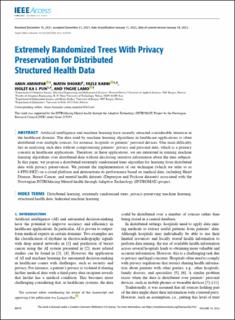| dc.contributor.author | Aminifar, Amin | |
| dc.contributor.author | Matin, Shokri | |
| dc.contributor.author | Rabbi, Fazle | |
| dc.contributor.author | Pun, Violet Ka I | |
| dc.contributor.author | Lamo, Yngve | |
| dc.date.accessioned | 2022-06-28T12:27:40Z | |
| dc.date.available | 2022-06-28T12:27:40Z | |
| dc.date.created | 2022-01-21T14:29:43Z | |
| dc.date.issued | 2022 | |
| dc.identifier.issn | 2169-3536 | |
| dc.identifier.uri | https://hdl.handle.net/11250/3001336 | |
| dc.description.abstract | Artificial intelligence and machine learning have recently attracted considerable attention in the healthcare domain. The data used by machine learning algorithms in healthcare applications is often distributed over multiple sources, for instance, hospitals or patients’ personal devices. One main difficulty lies in analyzing such data without compromising patients’ privacy and personal data, which is a primary concern in healthcare applications. Therefore, in these applications, we are interested in running machine learning algorithms over distributed data without disclosing sensitive information about the data subjects. In this paper, we propose a distributed extremely randomized trees algorithm for learning from distributed data with privacy preservation. We present the implementation of our technique (which we refer to as k -PPD-ERT) on a cloud platform and demonstrate its performance based on medical data, including Heart Disease, Breast Cancer, and mental health datasets (Depresjon and Psykose datasets) associated with the Norwegian INTROducing Mental health through Adaptive Technology (INTROMAT) project. | en_US |
| dc.language.iso | eng | en_US |
| dc.publisher | Institute of Electrical and Electronics Engineers (IEEE) | en_US |
| dc.rights | Navngivelse 4.0 Internasjonal | * |
| dc.rights.uri | http://creativecommons.org/licenses/by/4.0/deed.no | * |
| dc.title | Extremely Randomized Trees With Privacy Preservation for Distributed Structured Health Data | en_US |
| dc.type | Journal article | en_US |
| dc.type | Peer reviewed | en_US |
| dc.description.version | publishedVersion | en_US |
| cristin.ispublished | true | |
| cristin.fulltext | original | |
| cristin.qualitycode | 1 | |
| dc.identifier.doi | 10.1109/ACCESS.2022.3141709 | |
| dc.identifier.cristin | 1987466 | |
| dc.source.journal | IEEE Access | en_US |
| dc.source.pagenumber | 6010-6027 | en_US |
| dc.relation.project | Norges forskningsråd: 259293 | en_US |
| dc.identifier.citation | IEEE Access. 2022, 10, 6010-6027. | en_US |
| dc.source.volume | 10 | en_US |

